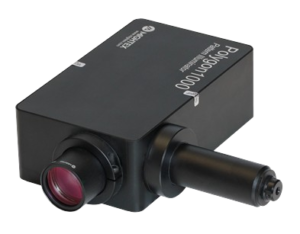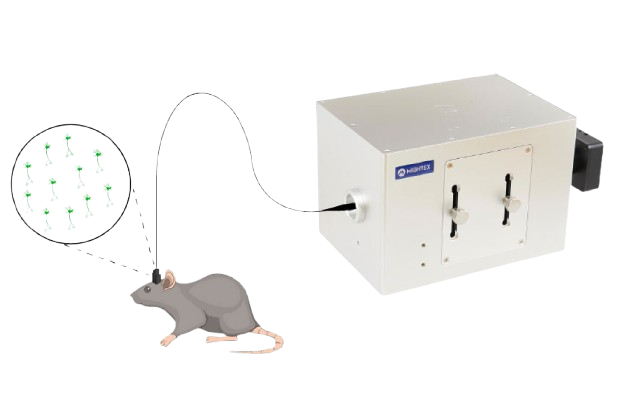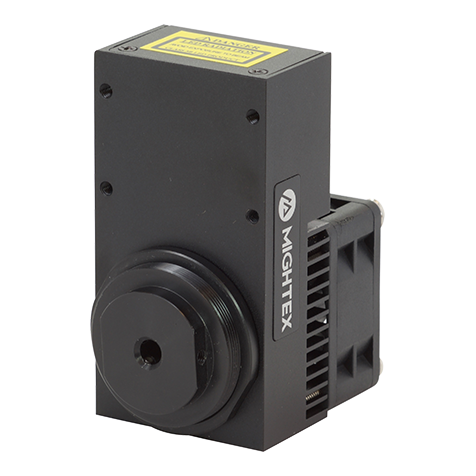Patterned Illumination

Polygon
DMD Pattern Illuminator for Targeted Photostimulation
Mightex’s market-leading Polygon DMD pattern illuminator provides precise spatiotemporal control of light with subcellular resolution, making it the perfect illumination tool for life science research.The Polygon uses digital mirror device (DMD) technology to illuminate multiple regions simultaneously. A DMD is composed of hundreds of thousands of micro-mirrors that can be individually turned on to reflect light onto the sample. Thus, you can control each mirror to control the area(s) of illumination and create any number of different sized patterns. The Polygon DMD pattern illuminator can be mounted into the infinity-path of any microscope.

Polygon 1000-G
Lightguide-input, ‘Standard’ Pattern Illuminator
The Polygon1000-G is a flexible solution for patterned illumination, as this patterned illuminator can be used with any lightsource (350-1000nm) that accepts a 3mm core lightguide. Thus, the Polygon1000-G provides future flexibility for different wavelengths and lightsources, depending on your application.Wavelengths: 350-1000nm*
Lightsource: lightguide-coupled
Add-on front tube available for large field of view

Polygon 1000-DL
Fiber-input, with Higher Optical Output for a Large FoV
The Polygon1000-DL is a flexible solution for a large field of view or high-power patterned illumination applications, as this patterned illuminator can be used with any fiber-coupled lightsource (400-1000nm), such as high-power lasers. This Polygon1000 model has been designed for high-power applications, such as in vivo optogenetics.Wavelengths: 400-1000nm
Lightsource: fiber-coupled

Polygon UHC
Ultra High Contrast DMD Pattern Illuminator
Mightex’s market-leading Polygon DMD pattern illuminators provide precise spatiotemporal control of light with subcellular resolution, making them the perfect illumination tool for life science research. The Polygon UHC incorporates the latest in digital micromirror technology to achieve the greatest available contrast ratio of 10,000,000:1, unlocking countless research opportunities for the bioscience community.The latest digital micromirror technology in the Polygon UHC achieves market-leading contrast ratio. That is, the greatest ratio of the light intensity of an all-on image to an all-off image. The higher the contrast, the better the background light can be suppressed.
In Vivo Imaging and Stimulation

OASIS Implant
Freely-Behaving Imaging and Optogenetics
The OASIS Implant is a ground-breaking platform for simultaneous cellular-resolution optogenetics and calcium imaging in freely-behaving animals to probe complex neuronal networks.To offer neuroscientists the ability to stimulate and visualize individual neurons in freely-behaving animals, Mightex’s engineers went back to the drawing board and pioneered a new path in the in vivo calcium imaging field. Instead of miniaturizing and placing the microscope on the animal – thereby limiting the microscope’s features and the animal’s behaviour – we kept the microscope off the animal’s head by using an imaging fiber.
By keeping the microscope away from the animal’s head, the OASIS Implant accomplishes 2 main goals:
1. Maximize Microscope Performance; Integrated Patterned Stimulation, Unlimited Illumination Sources, Scientific-Grade Cameras.
2. Optimize Behaviour; Compact and up to 3x lighter headmount. No electronics on the head of the animal.

OASIS Macro
Mesoscopic Optical Imaging and Optogenetics
The OASIS Macro is a mesoscope for all-optical targeted optogenetics, calcium imaging, and intrinsic imaging. The OASIS Macro enables researchers to simultaneously image the entire mouse cortex and perform targeted optogenetics (with Mightex’s market-leading Polygon DMD illuminator).Mightex’s OASIS Macro is designed as a reconfigurable mesoscope for in vivo imaging and optogenetics. The final system can be tailored to performance requirements for unique applications. This can include major features such as adding a second and third illumination source, or a dual-camera imaging system, as well as fine details including compatibility features for certain cameras and objectives.

OASIS Micro
Local Population Imaging and Optogenetics
The OASIS Micro is a ground-breaking microscope platform for all-optical cellular-resolution optogenetics and imaging in small cortical or deep-brain areas of a head-fixed animal. Simultaneously image small cortical or deep brain regions and perform neuron-specific targeted optogenetics with the addition of Mightex’s Polygon pattern illuminator.Mightex’s OASIS Micro is designed as a reconfigurable optical microscope system for in vivo imaging and optogenetics. The final system can be tailored to performance requirements for unique applications. This can include major features such as adding a second and third illumination source, or a dual-camera imaging system, as well as fine details including compatibility features for certain cameras and objectives.
Fluorescence Microscopy Cameras

CXE Cameras
Mightex C-series CCD USB 2.0 area cameras provide higher-sensitivity than CMOS cameras. They are optimized for fluorescence imaging, and they can also be used for a wide-variety of other microscopy applications where quality, ease of use, and cost-effectiveness are crucial. These cameras have external trigger-in and strobe-out. A USB command set protocol is provided for non-Windows based applications. A Linux drive is also available upon request.
Applications:
Live-cell fluorescence imaging
Fluorescent protein imaging
Ratiometric imaging
Immunofluorescence imaging
Phase contrast, DIC, & bright-field
General Purpose Microscopy Cameras

SCX Cameras
The SCE-series is Mightex’s entry level general purpose microscopy camera. The SCE-series is a low-cost imaging solution featuring a 1/3″ MP CMOS sensor with 5.2um x 5.2um size pixels. SCE-series camera has a 20fps frame rate at full resolution and higher framre rates can be achieved in ROI mode. Applications include, transmitted light microscope and wide-field imaging in research or teaching lab environments. The low-cost of the SCE_series camera makes it a great choice as a general purpose microscopy camera.
Applications:
Transmitted light microscopy
Live-cell imaging
Teaching lab equipment
BioLED Sources and Controllers

Microscopy LEDs
For many bioscience applications such as optogenetics, precisely-timed and high-intensity light pulses are required to activate channelrhodopsins (ChR2, ChR1 etc.) and halorhodopsins (NpHR), in order to excite and/or inhibit neurons using a microscopy light source. Other applications, such as Calcium imaging or voltage imaging, call for light sources which offer not only powerful and stable illumination, but also fast response time and long lifetime. Mightex has developed a wide range of market-leading BioLED sources for such applications.

Fiber-Coupled LEDs
Mightex fiber-coupled light sources are modularized fully-customizable turn-key solutions for optogenetics, fluorescence excitation, and other biophotonics applications. For example, precisely-timed and high-intensity light pulses are required in optogenetics experiments to activate channelrhodopsins (ChR2, ChR1 etc.) and halorhodopsins (NpHR) in order to excite and inhibit neurons. Mightex has developed a comprehensive portfolio of FCS-series single-wavelength and WFC-series multi-wavelength fiber-coupled LEDs, in order to meet a wide range of bioscience research needs.

Lightguide-Coupled LEDs
Mightex BLS-series BioLED light sources are modularized fully-customizable turn-key solutions for optogenetics, fluorescence excitation, and other biophotonics applications. Precisely-timed and high-intensity light pulses are required in optogenetics experiments to activate channelrhodopsins (ChR2, ChR1 etc.) and halorhodopsins (NpHR) in order to excite and inhibit neurons. To meet these requirements, Mightex has developed a proprietary “IntelliPulsing” technology to allow BLS-series sources to output significantly higher power in pulse mode than what the LEDs are rated for in CW mode.

Spotlight LEDs
Mightex BLS-series precision LED spotlight employ the latest high-power LED technologies and a proprietary coupling optics to achieve the best beam uniformity. In conjunction with BioLED light source control modules, these LED sources can be used for a wide range of applications including optogenetics and other bio-photonics applications.

Manual/Analog LED Controllers
Mightex BLS-1000-2, BLS-3000-2, BLS-13000-1, and BLS-18000-1 LED controllers are designed for driving Mightex LED sources. The controllers have two operation modes:
Manual Mode: the output current can be controlled by manually turning the knobs; or
Trigger Mode: the output current can be controlled via an external analog input signal between 0 ~ 5V.
The control mode is selected with a slide switch on the front panel, and the factory default is “Manual” mode. BLS-1000-2 and BLS-3000-2 provide Maximum Current Selection DIP switches on the rear panel, which allow the user to set the maximum output current of the channel to 500/750/1,000mA for BLS-1000-2, and 1,000/2,000/3,000mA for BLS-3000-2, respectively. The factory default is set to 500mA for BLS-1000-2 and 1,000mA for BLS-3000-2, respectively. BLS-13000-1 and BLS-18000-1 has only one maximum current setting of 13,000mA and 18,000mA, respectively.
When the controller is set to “Trigger” mode, the output current is fully controlled by the input analog signal (0-5V).

Multi-Wavelength Collimated LED Sources
Multiple LED sources can be efficiently combined into a single output beam, and offer major advantages such as long life-time, easily tunable spectrum, high power stability, and ultra-fast switching (on the microseconds level) without using moving mechanical components. Multi-Wavelength Collimated LED Sources find many applications in microscopy, spectroscopy, chemistry, and other physical science application, where light in different wavelengths can be combined into a single collimated output beam that is often further coupled into an optical systems. The highly collimated multi-wavelength output beam is suitable for working with lenses, filters, dichroic, mirrors, and many other optical components, while simultaneously allowing the user to tailor the spectrum to best suit the specific application requirements.
When the controller is set to “Trigger” mode, the output current is fully controlled by the input analog signal (0-5V).
Want to know more?
Do you wish to reach out for more information or see how we can help you? Reach out to us by clicking the button below!

